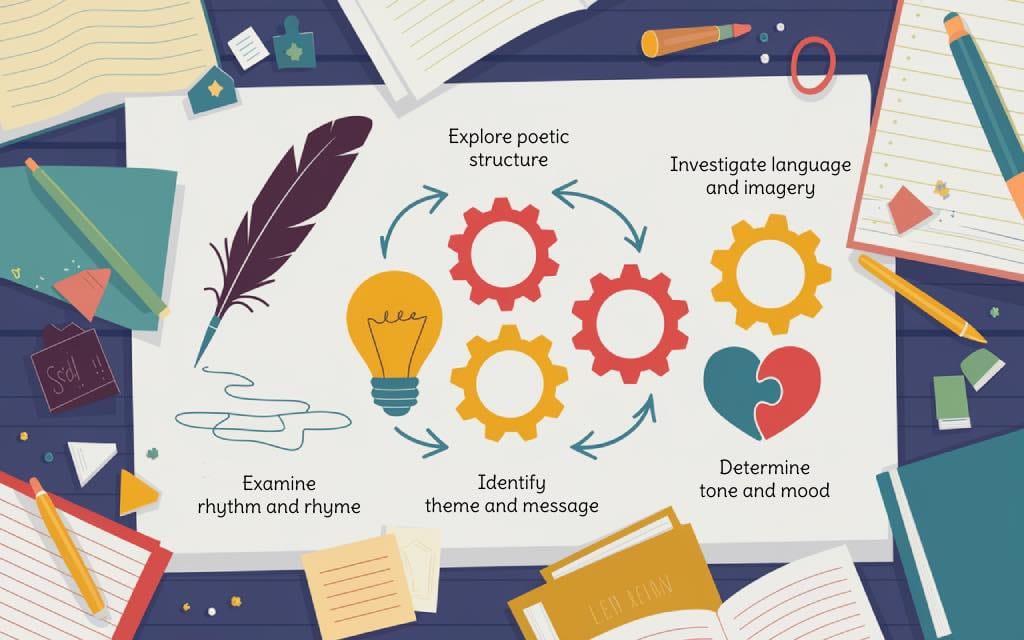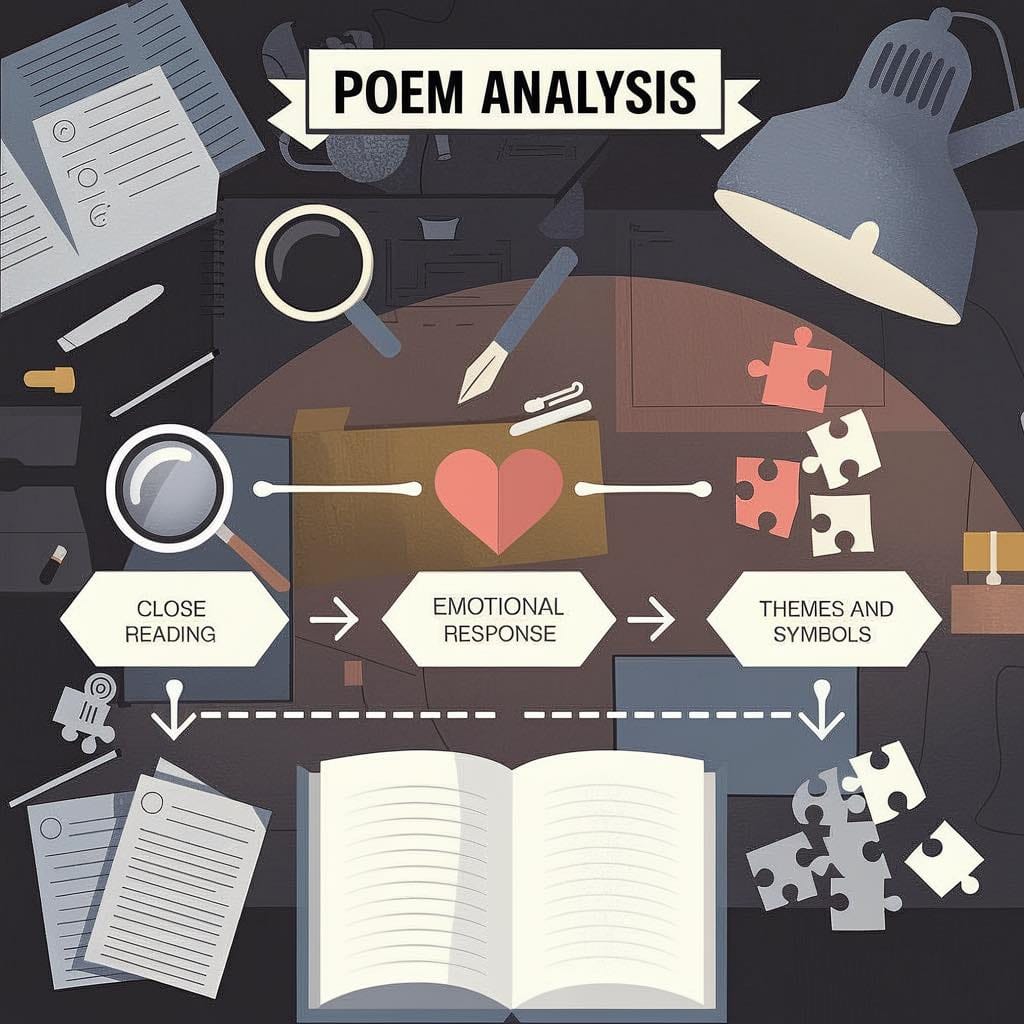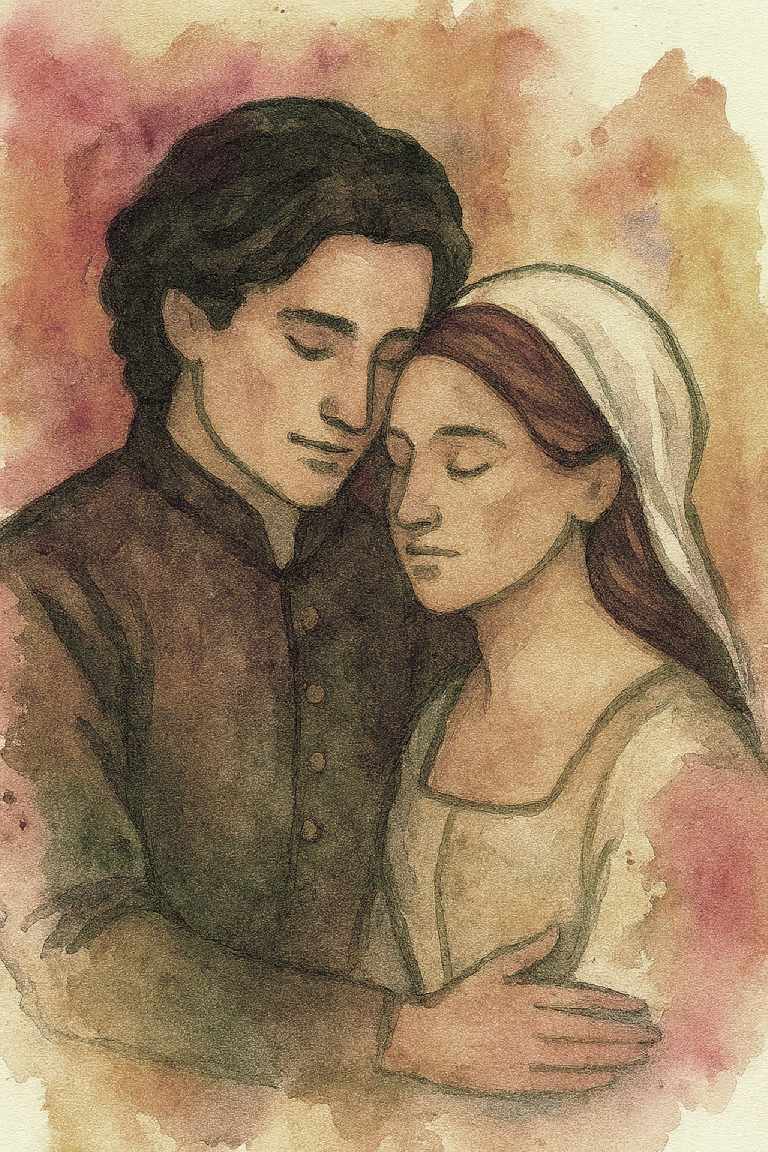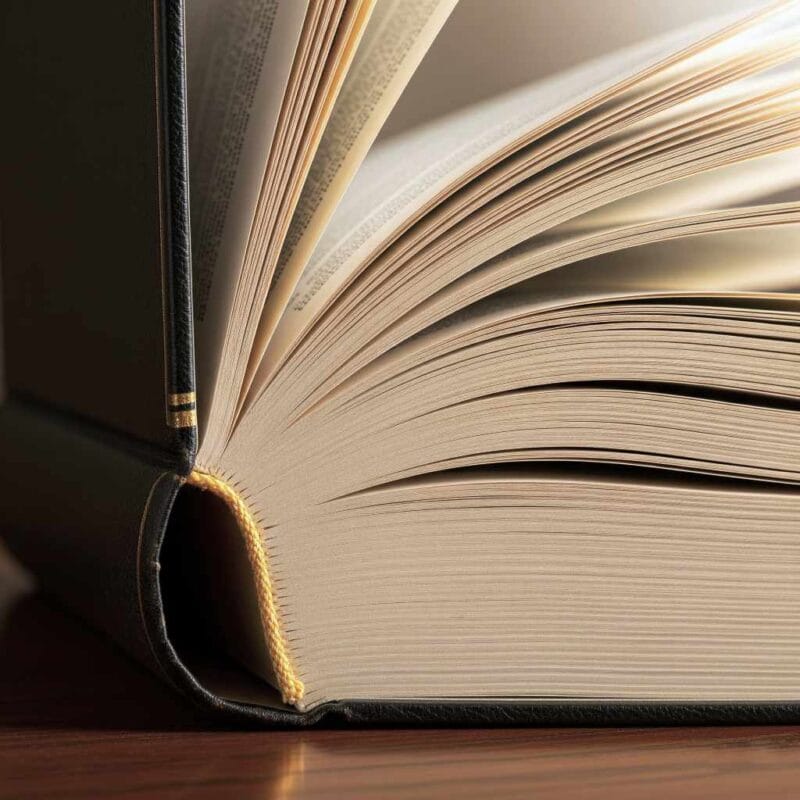- Poem analysis involves breaking down a poem’s language, structure, and stylistic choices to reveal its thematic layers. This process goes beyond summarization and involves careful attention to rhythm, rhyme, imagery, and tone. A structured approach enhances engagement with the text and provides insight into the poet’s intent.
- Steps to Analyze a Poem:
1. Examine the title: Consider how the title hints at the poem’s subject or theme.
2. Interpret the literal meaning: Read the poem carefully to understand its surface meaning.
3. Explore poetic structure: Analyze the number of stanzas, line lengths, and rhythm.
4. Investigate language and imagery: Look for metaphors, similes, and strong visual elements.
5. Determine tone and mood: Identify how word choice shapes the poem’s emotional effect.
6. Identify theme and message: Find recurring symbols or motifs that convey deeper ideas.
7. Examine rhythm and rhyme: Consider how the poem’s sound patterns influence its meaning. - Common Mistakes in Poem Analysis:
– Ignoring structure and sound
– Over-relying on the poet’s biography
– Assuming a single, fixed interpretation
– Misreading metaphor and symbolism - A thoughtful analysis requires multiple readings to uncover shifts in meaning, contradictions, and subtle details.
Poetry often appears mysterious until one examines it with attentive precision. It can seem like a puzzle whose true image only emerges when you carefully consider each element. Whether encountering subtle word choices, unexpected structures, or striking images, a thoughtful inspection reveals the careful planning behind every verse.
Poem analysis is the practice of examining a poem’s language, form, and stylistic features to uncover its hidden workings. It involves more than a simple summary; it requires a focused look at how rhythm, rhyme, and visual details interact to create the overall effect of the piece. By studying elements such as word choice, structure, and sound, you begin to see how each part contributes to the work’s overall impact.
This guide offers a systematic approach to exploring poetry. By breaking a poem into its fundamental parts—from language and form to imagery and symbolism—you will discover methods that illuminate the poet’s choices and intentions. Whether you are a student, a scholar, or someone who cherishes expressive writing, these strategies provide a clear pathway to appreciating the craftsmanship embedded in every line.
Importance of Analyzing Poetry

Analyzing poetry not only deepens one’s admiration for the craft behind every verse but also clarifies the poet’s intentional design. By closely examining sound devices—such as the strategic use of alliteration—and noticing shifts in structure, one uncovers how the poet manipulates language to shape meaning. For example, the repetition of the “s” sound in a line can evoke a sense of tranquility or, in a different setting, introduce an element of tension.
Consider a poem where a falling leaf symbolizes isolation—the interplay between movement and stillness forms a striking visual image that reveals much about the poet’s technique. Analyzing examples like George Gordon Byron’s The Destruction of Sennacherib (1815) and Claude McKay’s Harlem Shadows (1922) illustrates how specific devices such as interlocking meter, precise rhyme, and symbolic language work together to present themes of drama, struggle, and perseverance.
Additionally, the way stanzas are organized and the form chosen—whether adhering to the disciplined structure of a sonnet or embracing the freedom of free verse—reinforces the central message of the piece. This attentive exploration of technical elements not only enhances engagement with the poem but also illuminates the specific decisions that give the work its distinctive character.
Key Elements in Poem Analysis

Structure and Form
The arrangement of lines and stanzas creates a framework that influences the flow of the poem. A form like a sonnet often adheres to strict rules—such as the use of iambic pentameter—that can heighten the impact of the message. By contrast, free verse might offer a more spontaneous feel. The physical layout of the poem is always a deliberate choice that amplifies its overall effect.
Language and Imagery
Words are the building blocks of poetry. Vivid images and comparisons enable the text to evoke sensory impressions. For instance, a simile that likens nervousness to “a feather adrift in the wind” quickly communicates a delicate state. The careful selection of adjectives and verbs creates a strong visual picture, which encourages thoughtful reflection on what is being described.
Tone and Intonation
The poet’s choice of language establishes the work’s mood. Specific sound patterns and rhythms influence how the piece is perceived. Variations in intonation ensure that the poem remains engaging and thought-provoking throughout by highlighting moments of contemplation or urgency.
Symbolism and Themes
Recurring symbols provide a window into the broader ideas the work addresses. Whether the focus is on love, loss, or transformation, these elements serve as anchors for the text’s central message. Recognizing how such symbols function helps clarify what the poet intends to express.
Techniques for Effective Poetry Analysis

Use of Literary Devices
Examine how metaphors, similes, and personification contribute to the work’s impact. In T.S. Eliot’s “The Love Song of J. Alfred Prufrock” (1915), for example, urban imagery conveys the inner state of the speaker, which highlights the contrast between a monotonous existence and the desire for something more vivid. These devices are essential for conveying complex ideas succinctly.
Examining Poetic Devices
Analyzing the metric structure and the arrangement of stresses in a line can reveal the deliberate rhythm behind the poem. A Shakespearean sonnet, for instance, relies on the regular beat of iambic pentameter that lends the verse a musical quality. Recognizing these formal choices can clarify how they support the work’s central message.
Analyzing Speaker and Audience
The interaction between the poem’s voice and its intended audience significantly shapes interpretation. In “Prufrock,” the speaker’s introspective dialogue conveys hesitation and self-reflection. Paying attention to this dynamic can illuminate the personal perspective embedded within the poem.
Steps to Analyze a Poem

- Examine the poem’s title
The title often offers an initial hint about the subject matter. In Robert Frost’s “The Road Not Taken” (1916), for example, the title suggests the impact of choices. Reflect on the title before moving on to the rest of the text to form an initial connection with the poem. - Interpret the literal meaning
Begin with a straightforward reading to capture the plain depiction or scene the poem presents. Reading aloud can reveal the auditory qualities of the verse. Focus on identifying the setting, characters, and actions described. This step lays the groundwork for a more detailed exploration of the text. - Explore poetic structure
Analyze the organization of the poem by noting the number of stanzas, line lengths, and overall rhythm. Whether the poem follows a traditional form like a sonnet or opts for the freedom of free verse, the structure is a deliberate choice that shapes how the content is conveyed. - Investigate language and imagery
Pay close attention to the poet’s word selection. Metaphors, similes, and vivid images work together to form a striking picture. Consider William Shakespeare’s opening question, “Shall I compare thee to a summer’s day?” which employs natural imagery to create a clear visual impression. Each figurative expression contributes to the work’s atmosphere. - Determine tone and mood
Diction and syntax play a significant role in establishing tone. A poem might evoke a somber, reflective mood or a buoyant, energetic one. By identifying these qualities, you can discern the emotions the poet wishes to convey. - Identify theme and message
Look for recurring symbols or motifs that hint at larger ideas about life, love, or other universal topics. In the work of Emily Dickinson, themes of mortality often emerge through understated imagery and deliberate word choice. Noting these elements helps reveal the work’s central focus. - Examine rhythm and rhyme
Assess the musical qualities of the poem by examining its meter and rhyme scheme. A steady rhythm can create a sense of harmony, while irregular patterns might mirror chaos or uncertainty. The deliberate use of sound and pause plays a pivotal role in the poem’s progression.
Example Analysis of Key Poems
Robert Frost’s “The Road Not Taken”

The title immediately suggests a focus on choices and the consequences that arise from them. It invites the reader to think about the impact of decisions and the roads we choose in life. At face value, the poem describes a traveler in a yellow wood who must decide between two diverging paths. This straightforward narrative of a journey sets up the metaphor for decision-making in life.
The poem is composed of four stanzas of five lines each. Its regular structure and rhyme scheme help reinforce the contemplative nature of the speaker’s decision, as the form mirrors the deliberative process of choosing one path over another.
Vivid imagery—such as the depiction of a “yellow wood” and the contrasting roads—creates a visual representation of choices. The language is deliberately simple yet evocative, drawing the reader into the reflective atmosphere of the piece.
The tone is thoughtful and introspective, with a touch of wistfulness as the speaker considers the consequences of his choice. The mood is both contemplative and slightly melancholic, which further reflects on how different choices shape one’s life. The steady rhythm and consistent rhyme scheme provide a meditative beat that mirrors the internal debate of the speaker, emphasizing the structured yet unpredictable nature of life’s choices.
The central theme of the poem is the inevitability of choices and the irreversible nature of decision-making. The work suggests that the paths we take define who we are, even if we cannot know the outcome of the road not chosen.
Percy Bysshe Shelley’s “Ozymandias”

The title references Ozymandias—the Greek name for an ancient Egyptian ruler—hinting at themes of power, legacy, and inevitable decline. The poem describes the discovery of a ruined statue in a vast desert, a remnant of a once-mighty king whose empire has crumbled into oblivion. Although brief, the poem’s near-sonnet form—with a defined volta—mirrors the rise and fall of Ozymandias’s reign. This compact structure emphasizes the transient nature of power and glory.
Shelley uses striking imagery to contrast the grandeur of the past with the desolation of the present. The “colossal wreck” set against the barren desert powerfully conveys the futility of hubris and the ravages of time. The tone is ironic and reflective, which underscores the ephemeral nature of human achievement. The mood is somber and cautionary, which provokes the reader to contemplate the limits of power.
The controlled meter and rhyme scheme lend the poem a formal quality that contrasts with the chaotic, crumbled imagery. This juxtaposition highlights the tension between human ambition and nature’s enduring forces. In terms of themes and messages, “Ozymandias” warns of the inevitable decay of all rulers and empires. It explores themes of impermanence, the arrogance of power, and the relentless passage of time.
William Ernest Henley’s “Invictus”

The title, meaning “unconquered” in Latin, immediately conveys a sense of defiance and inner strength, setting the tone for a struggle against adversity. The poem narrates the speaker’s unwavering determination in the face of hardship. It is a declaration of self-mastery and the ability to triumph over external challenges.
The poem is structured in four stanzas with a consistent meter and rhyme scheme, reinforcing the steady, unyielding spirit of the speaker. Its deliberate form reflects the disciplined resolve conveyed in the verses.
Henley’s language is direct and impactful, with vivid imagery such as “black as the pit” to describe despair and darkness. These images create a stark contrast between the hardships faced and the strength of the human spirit.
The tone remains steadfast and bold, carrying a quiet force that speaks to confidence and resolve. Strength and solemnity shape the mood and reflect life’s challenges while affirming the individual’s ability to endure. The measured beat and precise rhyme scheme lend the poem a steady, unwavering cadence. This structure reinforces the theme of resilience and an unyielding will, which echoes the spirit of defiance that runs through every line.
Lord Byron’s “She Walks in Beauty”

The title immediately signals admiration and celebration of feminine grace and beauty, which sets an appreciative tone for the poem. The poem offers a description of a woman whose beauty is both striking and harmonious. It portrays not only physical attractiveness but also an inner glow that radiates through her demeanor.
Byron employs rich, natural imagery to liken the woman’s beauty to elements of the night sky and other serene vistas. The comparisons evoke a vivid sensory experience, which highlights both her external allure and inner virtue. A consistent rhythmic flow and carefully crafted rhyme scheme give the poem a musical quality that reinforces the delicate balance and elegance of the subject’s character.
Structured in neatly arranged stanzas with a consistent meter, the poem’s form mirrors the balanced and graceful qualities it describes. The orderly progression of the lines reinforces the serene and reflective nature of the tribute. A spirit of genuine respect and tender care imbues every word with warmth and reverence, while the overall mood remains serene and uplifting—its beauty revealed both in the lines and in the spaces between.
The poem explores themes of beauty, harmony, and the unity of inner and outer qualities. It suggests that true beauty is not merely a matter of appearance but also reflects an inherent, gentle dignity.
Common Mistakes in Poem Analysis
Analyzing poetry requires a careful approach, yet certain missteps can lead to a shallow or misguided interpretation. Overlooking key elements or applying rigid assumptions often weakens the depth of an analysis. Below are common errors that can hinder a thorough examination of a poem.
- Treating the poem as a simple summary
One of the most frequent mistakes is reducing a poem to its literal meaning without considering the layered use of language, structure, and symbolism. A poem is not merely a narrative or a collection of statements; it is a crafted piece where every word, line break, and sound serves a purpose. Ignoring these elements results in an incomplete reading that fails to capture the poem’s depth. - Neglecting poetic structure and form
Each poem follows a deliberate form, whether it is a sonnet, villanelle, or free verse. Some readers overlook the significance of structure, assuming that the content alone carries the meaning. However, form shapes a poem’s rhythm, pacing, and overall impact. Dismissing this aspect leads to an incomplete understanding of the poet’s intentions. - Overlooking sound and musical qualities
Poetry is deeply connected to sound, and elements such as alliteration, assonance, rhyme, and meter contribute to its effect. Failing to consider how sound reinforces meaning can weaken an analysis. For instance, a poem with a steady, rhythmic flow may reflect order or control, whereas fragmented or disjointed lines may convey unrest or uncertainty. Recognizing these auditory elements is crucial to appreciating how the poem communicates emotion and meaning beyond its words. - Focusing too much on the poet’s biography
While historical and personal context can add depth to an analysis, an over-reliance on biographical details can lead to misinterpretations. A poem should be examined on its own terms rather than seen as a direct reflection of the poet’s life. While some works may draw from personal experiences, poetry often transcends autobiography to explore broader themes. - Ignoring tone and mood
Tone shapes the emotional texture of a poem, yet some analyses treat poetry as purely intellectual, overlooking its emotional weight. A failure to engage with the mood—whether solemn, celebratory, melancholic, or defiant—can strip the poem of its intended resonance. Recognizing how word choice, punctuation, and imagery set the emotional tone helps create a fuller appreciation of the work. - Relying on a single reading
A single reading rarely captures the complexity of a poem. Unlike prose, poetry often demands multiple readings to uncover hidden meanings, shifts in tone, and the interplay between language and form. Reading a poem aloud can reveal its rhythm and sonic qualities, while a second or third reading may highlight connections that were not immediately apparent. - Forcing a fixed interpretation
Some readers assume that a poem has only one correct meaning, yet poetry thrives on ambiguity and layered interpretation. While a strong analysis should be grounded in textual evidence, it should also allow room for multiple perspectives. Dismissing alternative readings in favor of a rigid interpretation limits engagement with the text. - Misinterpreting symbolism and metaphor
Poets frequently use symbols and metaphors to suggest ideas beyond their literal meaning. Some analyses either overlook these devices or interpret them too literally, missing the broader significance. For example, a storm in a poem may not just describe the weather but might symbolize turmoil or transformation. Careful attention to recurring symbols, context, and tone helps reveal the poem’s thematic layers. - Overemphasizing rhyme at the expense of meaning
While rhyme and meter contribute to a poem’s structure, focusing solely on these elements without considering their effect on meaning can be misleading. Some analyses fixate on the technical aspects of rhyme schemes without discussing how they enhance or contrast with the poem’s themes. A well-balanced reading considers both the poem’s sound and its substance. - Failing to recognize contradictions or shifts in meaning
Many poems contain shifts in tone, perspective, or meaning that unfold across stanzas or lines. Ignoring these transitions can lead to an incomplete analysis. Recognizing where the poem moves from one idea to another—such as a shift from doubt to certainty or from despair to hope—helps reveal its full complexity.
Further Reading
10 of the Best (and Easiest) Poems to Analyze by Emma Baldwin, poemanalysis.com
How to write poetry: Poet Wendy Cope explains what makes a really superb poem by Wendy Cope, The Guardian
The Most Misread Poem in America by David Orr, The Paris Review
[Help] How do you analyse poetry? on Reddit




